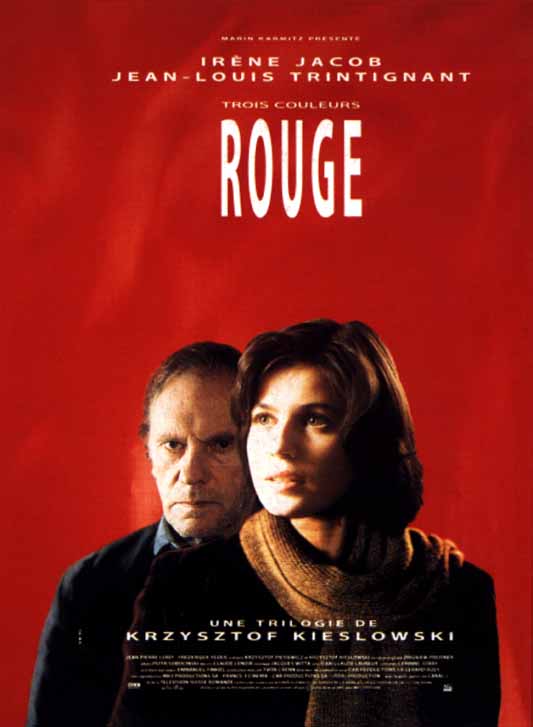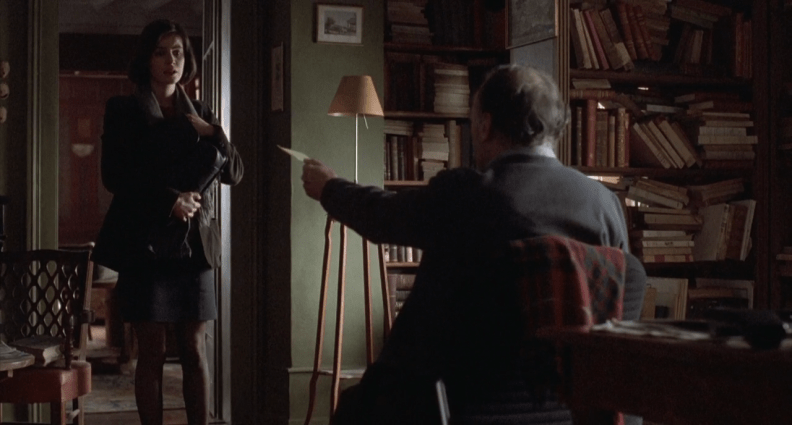Synopsis: A model in Geneva encounters a mysterious retired judge who eavesdrops on his neighbours, while her neighbour, a young lawyer, has romantic problems.
‘Rouge’ is the conclusion to Kieslowski’s European ‘Trois Couleurs’ trilogy. After France and Poland, we are now in neutral Switzerland. After liberty (‘Bleu’) and equality (‘Blanc’), Kieslowski gives us love, community, brotherhood. It is the warmest of the three films, emotionally and visually, with deep reds and burgundies everywhere (a car, a bowling alley, a café, a banner), and it is by far the most optimistic of the three. The film is concerned with connectiveness – and its absence, and the way in which Fate can play a hand, guiding us to something and giving us a second chance. I think Paul Thomas Anderson must have watched ‘Rouge’ an awful lot before he made ‘Magnolia’.
Chance and repetition are the dominant themes of the film. Irene Jacob plays Valentine (what a perfect name for the protagonist in a film about love), a fashion model, whose ad for something as mundane as chewing gum is a radiant vision against red. The image will recur at the film’s close as she and other characters from the Trilogy are rescued from a ferry sinking. Fate is playing a stronger hand in human affairs than we would like to think, and this idea is in keeping with what critic Annette Insdorf calls Kieslowski’s “compensatory vision” of the universe: if there is death, there is also the chance of rebirth.
Valentine’s neighbour Auguste (Jean-Pierre Lorit) is a lawyer preparing to take an exam that will make him a judge. He has a picture of a ballerina with an arched back, an idealised vision of female beauty, and the image is repeated when Valentine attends ballet class. Auguste is in the throes of love with a woman who will betray him. Auguste’s and Valentine’s paths cross several times, and on one of these occasions Auguste drops his law book, and it opens on to a page covering a topic he will face in his exams.
Shortly after this, Valentine runs over a dog. She brings it to its owner, an isolated and embittered character, Joseph (Jean-Louis Trintignant), who doesn’t want the dog back. Joseph spends most of his time eavesdropping on his neighbours’ telephone conversations, and the conversations give glimpses into lives that are all too mundanely human (love, infidelity, betrayal, lies). Joseph’s motivation for spying is not clear, other than the conversations he hears are more honest than anything he heard as a judge. Is he doing it because he can or because he saw too much of life from the bench? Is he looking for redemption of sorts? Possibly: he turns himself in.
His spying disgusts her until she discovers that one of his neighbours is a drug dealer (her brother is a heroin addict). Valentine and Joseph end up having a tentative friendship that feels far more important than the odd relationship she has with her boyfriend, Michel, whose voice we only hear on the telephone, and who sounds like a jealous, possessive asshole.
The neighbourhood café where Valentine goes is called Chez Joseph. She plays a one-armed bandit, usually counting on losing, and is rather distressed when she wins (three red cherries). Did the judge – at the other chez Joseph – have a hand in that? Indeed, does he cause the interference on Valentine’s car radio, distracting her and causing her to run over the dog? Toward the end of the film we learn that when Joseph was a law student, he also had a textbook fall open to just the right page. And also like Auguste, the younger Joseph was betrayed by a blond woman.
Is Auguste a young version of Joseph? And if so, will Joseph have a second chance at happiness with Valentine? Or is Joseph God, or a force of the Universe? The film wisely doesn’t answer any of these questions, letting the audience take away its own conclusions.
Was Irene Jacob cast because she bears resemblance to Juliette Binoche? (they have almost identical hairstyles). In fact, Kieslowski created the role of Valentine specifically for Jacob, and she had a lot of input on the character (mainly because she felt the role too idealised and underwritten). We should be thankful for this: Jacob’s contribution to the script made the film more interesting than it might have been otherwise.
‘Rouge’ echoes ‘Bleu’ and ‘Blanc’ at several points. Instead of the mouse and her babies of ‘Bleu’, we have a German Shepherd and her puppies. After the undercarriage of a car in motion in ‘Bleu’ and a suitcase on a conveyor belt in ‘Blanc’, Kieslowski shows us miles and miles of red telephone cables. A stooped old woman struggles to put a bottle into a recycling bin. In ‘Bleu’ the self-absorbed Julie didn’t see her. In ‘Blanc’ Karol doesn’t help her (they are equals, after all, so why should he?). But in ‘Rouge’ we finally have a moment of compassion as Valentine helps her. ‘Rouge’ and ‘Bleu’ also contain an inside joke: the Dutch composer Van den Budenmayer, a fictitious character that appeared in a couple of other Kieslowski films.
At the end, the Trilogy is concluded and we know that all has worked out well for the characters. We glimpse Julie and Olivier from ‘Bleu’, Karol and Dominique from ‘Blanc’, and Valentine and Auguste. One last question, though: what happened to Auguste’s dog? The final image of the film echoes Valentine’s photo shoot, and I think it is a fitting way to end Kieslowski’s career: a beautiful young woman in profile against a red background (putting Communist Poland behind him?), looking westward (to the rest of Europe?)
‘Rouge’ lost out to at Cannes to another film about interconnected lives, ‘Pulp Fiction’. Even Tarantino was surprised, saying he thought ‘Rouge’ should have won. It almost didn’t qualify for the Foreign Language Film category at the Academy Awards – being not quite French, not quite Polish – until many directors and actors petitioned for it to be considered as a Swiss entry.
‘Rouge’ had a huge effect on Tom Tykwer: you can see echoes of it in ‘Run, Lola, Run’, and it helps explain why he was drawn to ‘Cloud Atlas’. Tykwer was selected to direct ‘Heaven’, one of another trilogy that Kieslowski and Piesiwicz were working on at the time of Kieslowski’s death.
Niall McArdle
http://www.ragingfluff.wordpress.com/
Have you seen Trois Couleurs: Rouge? What did you think? Please tell us your thoughts here at A World Of Film. Also, if you are interested in writing for us, send a message and an example of your writing to aworldoffilm@outlook.com
You can now also add us on Facebook at https://www.facebook.com/aworldoffilm







Another terrific analysis of a modern classic Niall. I still prefer ‘Blue’, though the performance of Trintignant in this film almost steals it. He is one of my favourite actors from the days of the New Wave, and he is also in one of my favourite films, Bertolucci’s ‘The Conformist’ (1970).
Regards from Norfolk, Pete.
I can`t believe how this stunning film lost at Canner. Fifth rate mediocrity from a hacker sometimes compensates.